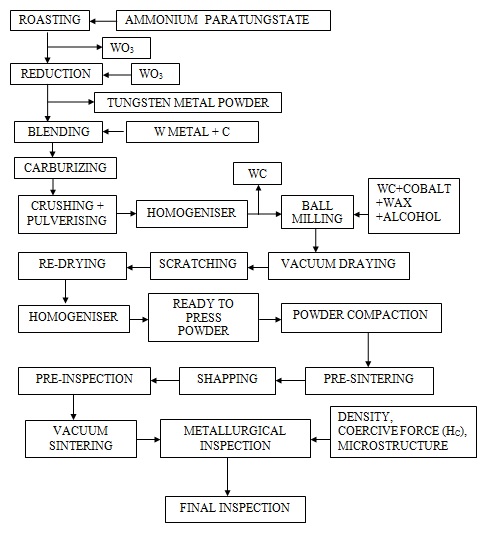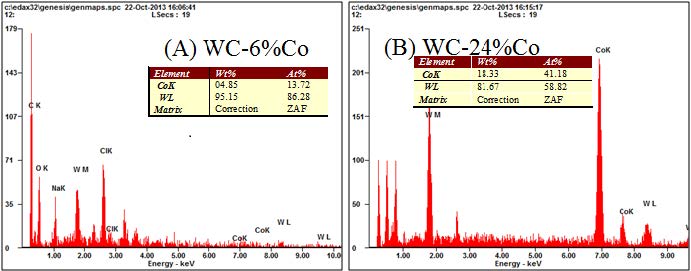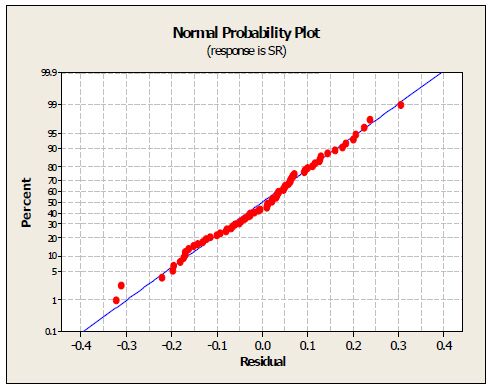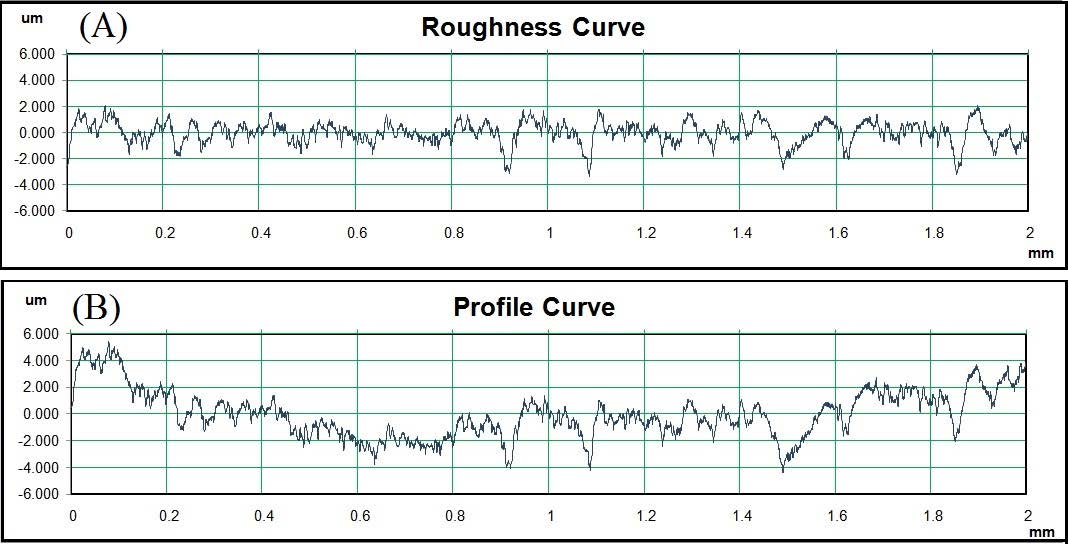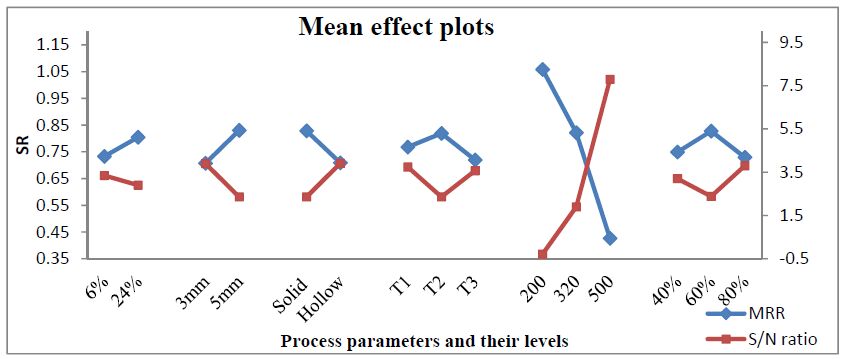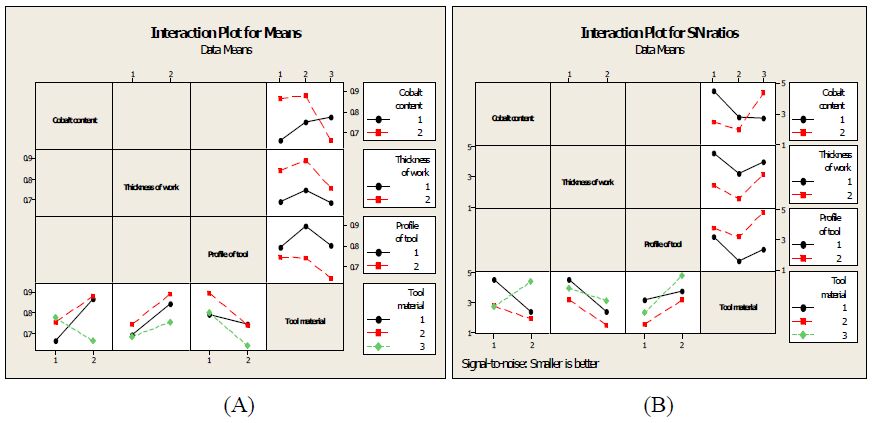In manufacturing industries, the demand of WC-Co composite is flourishing because of the distinctive characteristics it offers such as: toughness (with hardness), good dimensional stability, higher mechanical strength etc. However, the difficulties in its machining restrict the application and competitiveness of this material. The current article has been targeted at evaluation of the effect of process conditions (varying power rating, cobalt content, tool material, part thickness, tool geometry, and size of abrasive particle) on surface roughness in ultrasonic drilling of WC-Co composite. Results showed that abrasive grit size is most influential factor. From the microstructure analysis, the mode of material deformation has been observed and the parameters, i.e. work material properties, grit size, and power rating was revealed as the most crucial for the deformation mode.
1.
Introduction
Climate anomaly derived from excessive carbon emission is an important issue related to the sustainable development of all aspects of human society, including politics, economy [1,2,3,4], environment and humanities [5,6,7,8,9,10]. The emission of greenhouse gas (GHG) is a strong contributor to the global warming [11]. The 2009 international energy agency (IEA) report showed that the total CO2 emissions from China surpassed that of the United States in 2007 and occupied the first place. In 2017, 30 percentage of global CO2 emission came from China [12]. In order to effectively control CO2 emission, the Chinese government is aware of the seriousness of uncontrolled CO2 emission, has written sustainable development into its national policy, and will continue to do so for a long time [13]. At the 2009 conference of UN climate change held in Copenhagen, China announced that, compared to the level of 2005, its CO2 emission per unit of gross domestic product (GDP) would be reduced by 40–45% at the end of 2020. At the Paris Climate Conference in 2015, it promised to further reduce this indicator by 60% to 65% by 2030 [14].
Agriculture is the lifeblood of human social development, especially for those countries with huge populations, as well as an important source of greenhouse gases. According to the intergovernmental panel on climate change (IPCC) regulations on land utilization, the agricultural sector is responsible for 23% of CO2 emission from this ecosystem (IPCC 2019). CO2 emission from agriculture is the second largest source of global greenhouse gas emission, contributing about 14% of global anthropogenic greenhouse gas emission and 58% of non-anthropogenic CO2 emission. Chinese agricultural CO2 emission account for 17% of the total greenhouse gas carbon emissions, and the annual average growth rate of emission level is about 5% [15,16]. Therefore, the research on agricultural CO2 emission can not only serve the sustainable development of the country, but also be conducive to environmental protection.
So far, various problems caused by agricultural CO2 emission have attracted the attention of many research institutions and scholars. For example, Huang et al. [17] studied the temporal and spatial changes of Chinese agricultural carbon emission in the period of 1997 to 2016, and pointed that Chinese agricultural CO2 emission generally increased, but its intensity weakened. They also found that the CO2 emission and CO2 emission intensity of different provinces were quite different, and the spatial correlation of CO2 emission was obvious, which showed a high aggregation in general. Balsalobre-Lorente et al. [18] analyzed whether agricultural activities in BRICS countries (Brazil, Russia, India, China, and South Africa) induced carbon emission, and found that an inverted U-shaped trend was evolved between CO2 emission and economic development, while the interaction between electricity consumption and agricultural activities had the additional deleterious effects on the environment. Wu et al. [19] explored the spatial characteristics and spillover effects of Chinese agricultural CO2 emission intensity in the period of 2001 to 2018, and discovered that the provincial emission intensity of agricultural CO2 showed a declining trend, but there was obvious heterogeneity in the rate of decline in different provinces. They also pointed that the spatial dependence of emission intensity for Chinese agricultural CO2 had an increasing trend, and the spatial spillover effect was prominent from 2001 to 2018. He et al. [20] studied the regional spillover effect of agricultural carbon emission from the perspective of technology diffusion, and pointed the "swarm effect" caused direct interaction of CO2 emission reduction in various provinces, and the spatial diffusion of agricultural technology progress was more likely to occur in areas with similar agricultural economic development. He et al. [21] worked at the nonlinear impact of agricultural industrial agglomeration on agricultural CO2 emission and concluded that it had a double threshold effect. With the formation of large-scale agricultural production, agricultural CO2 emission show an "inverted U" evolution trend. Meng et al. [22] explored the dynamic influence mechanism of agricultural CO2 emission in Heilongjiang Province and found that the most important influencing factor to the increase of agricultural CO2 emission was the agricultural economic level, followed by the agricultural production structure. In their work, the main influencing factor of restraining agricultural CO2 emission was the efficiency of agricultural production, followed by the scale of agricultural workforce.
Exploring the influencing factors of CO2 emission in various industries has become a hot issue studied by scholars [23,24]. In terms of mathematical algorithm, there are mainly three factor decomposition methods: index decomposition analysis (IDA), structural decision analysis (SDA), and logarithmic mean divisia index (LMDI). SDA method is mainly depended on the input-output table generally updated every five years, which limits the application of SDA method [25,26,27]. IDA is simpler in comparison and only needs to use department aggregate data, so it has been used by Zha et al. [28] and Balezentis [29]. LMDI decomposition method belongs to a branch of IDA method, which achieves full decomposition and no residual. It is a common way applied to study the internal causes of change and action intensity. Alajmi [30] revealed the action mechanism of CO2 emission from nine industries in Saudi Arabia from 1990 to 2016 through LMDI method. Their analysis shows that energy effect is the key role for increasing greenhouse gas emission, and the impact of activities and population also contributes to greenhouse gas emission. Moreover, the impact of activities, energy and population in the power sector is greater than that in the transport sector. Isik et al. [31] evaluate and reveal the generating mechanism of CO2 emission from the transportation sector based on LMDI in Turkey from 2000 to 2017. It was found that the research subject's CO2 emission was firstly driven by economic growth, following by the effect of population and emission intensity. Fatima et al. [32] discussed the main drivers of Chinese industrial CO2 emission from 1991 to 2016. Their study showed that the first two emission sources were income and labor effects. In addition, energy structure effect had its unique contribution for CO2 emission increasing. Energy intensity and carbon emission effect were the first two key factors for CO2 emission reduction. Quan et al. [33] selected IPCC method and LMDI model to calculate and decomposed the carbon footprint to logistics industry in the period of 2000 to 2016. Their results showed that economic growth had the greatest driving effect in carbon emission, following by the positive impact of population size and energy structure. The main inhibitory factor was proved to be energy intensity. For the agricultural sector, Liu et al. [34] adopted LMDI model to analyze the generating mechanism of agricultural CO2 emission in Shandong Province. Their results proved that production efficiency and industrial structure to agricultural sector, regional industrial structure and labor force played much in CO2 emission reduction, while the development level of regional economy and the urbanization rate were the main factors for the increase of agricultural CO2 emission. Xiong et al. [35] studied the influencing factors of agricultural CO2 emission in different stages in Xinjiang and found that economy was the key point to the increase of agricultural CO2 emission, while the efficiency factor played the opposite role. Hu et al. [36] discovered the characteristics and influencing mechanism about agricultural CO2 emission in China and concluded that for the whole country, production efficiency, agricultural industrial structure, and rural population were helpful to the reduction, and industrial structure, regional economic ability, and urbanization played the opposite roles.
How to explore excellent mathematical models for solving scientific problems [37,38] and discover the decoupling between CO2 emission and the economic development for various industries are issues worthy of attentions. The OECD [39] firstly put forward the concept of "decoupling index", and Vehmas et al. [40] proposed six possible theoretical frameworks for delinking and link analysis. At present, Tapio decoupling is a common method used by the researchers to find out the influence mechanism between economy and CO2 emission. Engo [41] applied the Tapio decoupling method to study the decoupling relationship between the CO2 emission and development of Cameroon's transport sector from 1990 to 2016. Their work showed that there were weak decoupling (WD), strong decoupling (SD), weak negative decoupling (WND), and strong negative decoupling (SND) during the study period. Raza et al. [42] also applied Tapio decoupling model to discover the decoupling state of CO2 emission for the transport sector in Pakistan from 1984 to 2018. It was found that CO2 emission showed expansive coupling (EC) decoupling during the period 1984–2018. The WD only occurred in the sub-periods of 1999–2003, 2004–2008, and 2009–2013. Wang et al. [43] also studied this topic of Chinese iron and steel industry based on Tapio decoupling model. They discovered that the carbon emission was weakly decoupled from economic growth. For the agricultural sector, Han et al. [44] studied the interaction between agricultural carbon emission and the development of economy in 30 provinces of China from 1997 to 2015, and found that on a regional scale, the decoupling degree between CO2 emission and economic development was stronger for the central provinces than that of western provinces, and 24 of all provinces showed the WD state. Liu et al. [45] analyzed the decomposition and decoupling of regional agricultural CO2 emission and declared the decoupling relationship between CO2 emission and economic development presented a gradual improvement process of first EC, then WD, and finally SD. The decoupling relationship in north, northeast, east and central China was better than that in northwest, southwest and south China, and the decoupling state of a single province fluctuated greatly. Hossain et al. [46] explored the decoupling mechanism between agricultural development and agricultural CO2 emission in Bangladesh and found that it showed WD in most of the time from 1990 to 2017.
In the above literature reviews, some studies have discussed the agricultural CO2 emission characteristics. In particular, for the researches focusing on CO2 decomposition, the LMDI method obtains relatively satisfied results. While studying the decoupling mechanism between economic development and CO2 emission, the Tapio model obtains the temporal and spatial changes of the decoupling relationship.
However, the studies reviewed above ignore the driving factors and decoupling mechanism between the overall agricultural CO2 emission and economic development. In addition, they rarely take Chinese agriculture sector as a research sample to specifically discuss the issue about driving factor and decoupling trend. This study aims to fill these gaps. The theoretical and practical contributions are summarized as follows: The IPCC is adopted to measure the agricultural CO2 emission and LMDI model is utilized to identify the impact factors for agricultural CO2 emission, and then Tapio model is developed to reflect the dependence of economic development on CO2 emission of Chinese agriculture. The research cycle of this paper is from 1996 to 2020. The whole period is divided into five sub-periods: 1996–2000, 2001–2005, 2006–2010, 2011–2015, and 2016–2020. In addition, this study also provides policymakers with suggestions on carbon emission reduction.
Figure 1 draws the structure of this paper, and the rest is organized as follows. The methodology and data details are given in Section 2, respectively. Section 3 describes the results and discussion, and Section 4 presents the conclusions and policy recommendations.
2.
Methodology and data
2.1. Calculation of CO2 emission
Considering the essential characteristics of agricultural production and the input of various factors, scholars have developed a more mature calculation algorithm about total CO2 emission from agricultural production. Researchers' decisions on the selection of carbon sources for agricultural CO2 emission measurement vary greatly [47]. Research on the sources of agricultural CO2 emission focuses on actual production, taking into account the emission directly or indirectly generated from the agricultural production, including chemical fertilizer, agricultural film, agricultural diesel and other carbon sources. In addition, this study draws lessons from the previous research results [48,49] and measures the CO2 emission of agricultural production from six major carbon sources, such as pesticide, chemical fertilizer, agricultural film, diesel, agricultural irrigation, and agricultural tillage.
In Eq (1), C indicates the total agricultural CO2 emission, Ci represents the CO2 emission of class ith source, Ti describes the number of class ith source, λi is the emission coefficient of ith CO2 source. The relevant emission coefficient of each CO2 source is listed in Table 1.
2.2. LMDI decomposition model
This study adopts LMDI to construct the decomposition model of agricultural CO2 emission in China. As the predecessor of LMDI model, the fundamental principle of index decomposition analysis (IDA) identity is to express a specific research object as the product form of relevant influencing factors (including agricultural production efficiency, production structure, economic development, and workforce in this paper) through the deformation of a series of mathematical identity formulas, and calculates the incremental balance of each influencing factor according to different weights. Considering this most essential mathematical characteristic, many researchers select IDA model to the study of energy consumption for analyzing the different effects of various influencing factors on the research object. The IDA identity is calculated by
where Vt is an energy-related aggregate or CO2 emission in period t (0 ≤ t ≤ aT), the subscript i is the distinguishing sign of influencing factor. General assumption of that there are n factors contributing to the changes in Vti and each is associated with a quantifiable variable, so it exists n quantifiable variables Xt1i, Xt2i, ⋯, Xtni. Take the logarithm of Vt and determine the derivative of period t to get the deformation of Eq (2):
Take definite integrals on both sides of the Eq (3):
In the above equation, the exact value cannot be calculated for the definite integral in brackets, and the capacity of each influencing factor is usually estimated by giving different weight functions. On this basis, Ang [50] proposed the LMDI, whose decomposition weight takes the average logarithmic for the two endpoints in the period.
Then the weight function is expressed in the following form.
Taking the weight function into Eq (4).
From the derivation process, it is concluded that the LMDI decomposition method based on logarithmic mean is a complete decomposition method and will not produce residuals. The form of logarithm makes multiplication and addition in the formula can be converted to each other. The LMDI decomposition formula based on addition is:
where
and ΔVrsd is zero, that is zero residual in the decomposition method of LMDI.
Combining the Kaya identity [50] of carbon emission with the above LMDI model, Kaya equation is introduced into this study. Through deformation, the annual CO2 emission C of agriculture is expressed as:
In Eq (10), C, A, G, and P represent agricultural CO2 emission, total agricultural output value, agricultural output, forestry, animal husbandry and fishery, and the number of agricultural workforces, respectively. CA, AG, IA, and IS represent production efficiency, production structure, economic development, and workforce of the agricultural sector, respectively.
Using LMDI, the change of CO2 emission is decomposed into above four influencing factors CA, AG, IA, and IS. Use the following Eq (11) to measure the change of CO2 emission in period t relative to the base period zero:
where ΔCtCA represents the efficiency effect of agricultural production, ΔCtAG represents the effect of agricultural production structure, ΔCtIA represents the economic development effect, ΔCtIS represents the scale effect of labor force. Each one is calculated by Eqs (12)–(15) respectively.
where L(C0,Ct) represents the logarithmic average weight defined as:
The contribution rate or effect value of each factor is:
2.3. Decoupling model
For evaluating the decoupling relationship between agricultural CO2 emission and economic development, this paper adopts Tapio model:
where β represents the decoupling index of Tapio; %ΔA indicates the change rate of agricultural production value, and %ΔC is the change rate of CO2 emission; Ct and C0 represent agricultural CO2 emission for the current periods t and zero, respectively; At and A0 indicate the agricultural production value for the current periods t and zero, respectively.
Tapio decoupling index defined in Eq (21) is a ratio, which shows the percentage change for agricultural CO2 emission if the value of agricultural production jumps by one percentage point. In order to explore a clearer decoupling trend for agricultural CO2 emission and economic development, we divide the decoupling trend into eight states, as shown in Table 2. It should be noted that: The eight states are determined by the logical relationship " & " between five variables (%ΔC, %ΔA, β, A, and C), rather than by a single variable, such as β.
If the agricultural economy grows significantly and the CO2 emission decrease rapidly, we define it as "strong decoupling" (SD) (when β < 0), which is the goal of achieving low-carbon agriculture. On the contrary, "strong negative decoupling" (SND) indicates the significantly decline of agricultural economy with the rapid emission of agricultural CO2 (when β < 0), which is the last thing we want to see in the process of achieving agricultural economic development. The remaining six states are between SD and SND. If the agricultural economy develops significantly with a dilatory emission of agricultural CO2 (when 0 < β < 0.8), it is defined as "weak decoupling" (WD). In case the agricultural economy slows down and CO2 emission drops sharply (when β > 1.2), it is defined as "recurrent decoupling" (RD). "Expansive negative decoupling" (END) indicates the slow development of agricultural economy with the rapid emission of agricultural CO2 (when β > 1.2). "Weak negative decoupling" (WND) indicates that the rapid retrogression of agricultural economy with the slow decline in agricultural CO2 emission (when 0 < β < 0.8). "Expansive coupling" (EC) means that both rapidly increase (when 0.8 < β < 1.2), while "recurrent coupling" (RC) shows that both decrease rapidly (when 0.8 < β < 1.2).
2.4. Data sources
In order to ensure the reliability of data, this study applies time series statistics, with a span of 1996–2020. The data of six major carbon sources of agricultural production are selected, among which the data of pesticide, chemical fertilizer, agricultural film, sowing area, diesel, GDP and irrigation area, agriculture, animal husbandry, fishery and forestry GDP, and total rural population are mainly from China Statistical and Rural Statistical Yearbook. For GDP of agriculture, agriculture, animal husbandry, fishery and forestry GDP, 1996 is the starting year, and comparable data are obtained.
3.
Results and discussion
Our empirical design is divided into three parts: Measurement of CO2 emission for agricultural sector, influencing factor decomposition, and analysis of decoupling trend. They are strictly corresponding to the three parts of the methodology section, and also in line with the design idea of empirical analysis, that is, the order of measurement, decomposition and decoupling. Each part of this section is closely related and has a connecting design rationality. In the first empirical analysis, we refer to literatures [48,49] and select six carbon sources for the measurement of agricultural CO2 emission. For the empirical analysis about decomposition, we comprehensively discuss the experimental results from two aspects of different five-year plans and different factors. In the subsection 3.3 of decoupling analysis, we present the discussion and analysis for the decoupling states of different five-year plans.
3.1. CO2 emission measurement for Chinese agricultural sector
The curve related to the CO2 emission in Figure 2 shows the phased trend. In addition, the contribution of each carbon source is quite different. It can be seen from Figure 2 that during the period from 1996 to 2020, the overall CO2 emissions from Chinese agricultural sector raised by 47.84%, from 53.49 million tons to 79.08 million tons. The CO2 emission curve of the agricultural sector is divided into two stages: a stable growth stage (1996–2015) and a rapid decline stage (2016–2020). During the first stage (1996–2015), the agricultural CO2 emission raised by 70.89%, and the total emissions increased from 53.49 million tons to 91.41 million tons. During the second stage (2016–2020), the reduction rate of agricultural CO2 emission was -14.32%. For the perspective of carbon source structure, from 1996 to 2020, the CO2 emission from chemical fertilizer were the largest, accounting for 60.27% as a whole, followed by rural diesel, film and pesticide, accounting for 14.07, 13.02 and 9.95%, respectively, while the CO2 emission from irrigation were small, accounting for 2.00%, and the CO2 emission from sowing were very small, only 0.68%.
3.2. Analysis of influencing factors
Table 3, Figures 3 and 4 present the statistical results which show that: From the perspective of contribution and contribution rate, agricultural workforce and agricultural production efficiency play two major roles in curbing CO2 emission, while agricultural economic development is the most key factor to promote the growth of CO2 emission. According to the five-year plans, the study estimates the impact of each factor during the period 1996–2020. Table 3 and Figure 3 present the results of factor decomposition from different aspects, where ∆CCA and ∆CAG represent the efficiency effect and the structural effect about agricultural production, respectively. ∆CIA represents the economic development effect, ∆CIS represents the scale effect of labor force, ∆C represents is the sum of the above four factors. From 1996 to 2020, 28.6469 million tons is the change of total CO2 emissions from the agricultural sector, of which the contributions from productive efficiency, productive structure, economic development, and labor are -20.4657 million tons, 5.5485 million tons, 76.8315 million tons and -33.2674 million tons, respectively. As shown in Figure 4, the respective contribution rates are -71.44, 19.37, 268.20 and -116.13%, respectively.
From the perspective of different five-year plans, the factor of agricultural economy plays a weak negative role to the CO2 emission during the period of ninth five-year plan. As shown in Figures 3 and 4, during 1996–2000, the contribution rate is -16.50%, reducing agricultural CO2 emission by 1.665 million tons. This is mainly because, as shown in Figure 5, during this period, agricultural GDP shows a tendency of increasing first and decreasing later, from 2043.3 billion in 1996 to 1856.4 billion in 2000.
Figures 3–5 show that, after the tenth five-year plan, the contribution of economic development for the agricultural CO2 emission starts getting stronger. From 2001 to 2005, the CO2 emission increases by 18.92 million tons to 2006–2010, the CO2 emission increases by 33.77 million tons, and the contribution rate reaches 291.68% from 162.74%. This is mainly because despite the short-term decline in agricultural CO2 emission in 2009 affected by the 2008 financial crisis, the agricultural GDP still reaches 3555.4 billion in 2010, and the growth rate reaches 38.97% in the period of eleventh five-year plan, while the agricultural workforce decreases rapidly, from 745 million to 656 million. During 2011–2015 and 2016–2020, economic growth slows down, while the agricultural workforce continues to decline, and the increase of CO2 emission caused by economic development is still about 22 million tons.
Moreover, Figure 5 concludes that: Although the agricultural workforce has decreased, their quality and agricultural technical skills have been continuously improved. Energy saving measure, emission reduction technology and strong risk resistance have promoted the growth of regional low-carbon agriculture.
Agricultural workforce plays the second key role for curbing CO2 emission. The factor of agricultural workforce had been inhibiting the rise of CO2 emission during the ninth to the thirteenth five-year plan. The CO2 emission was declined by 3.3916 million tons in the period of the ninth five-year plan, while the it was reduced by 14.3553 million tons from 2016 to 2020. This phenomenon shows that the force is gradually strengthened. As shown in Figure 5, in the past 25 years, the population of agricultural workforces had changed from 850.85 million to 509.79 million, and the proportion of reduction is about 40.08%. The main reason for this phenomenon is that under the background of industrialization and urbanization, a large number of farmers have transferred from agricultural industry to non-agricultural industry, and agricultural production has gradually concentrated in the hands of large grain growers. With the implementation of policies such as the land transfer system, the scale of agricultural production has expanded year by year.
Figure 6 concluded that the efficiency of agricultural production promotes firstly and inhibits later agricultural CO2 emission. The change time of inhibition occurs at the period of eleventh five-year plan, that is, before 2006–2010, the factor of agricultural production efficiency promotes the increase of CO2 emission, while during the eleventh to the thirteenth ones, it inhibits CO2 emission. This is mainly because at the period of ninth five-year plan, the government did not make much efforts to control the agricultural environment, the agricultural economic development could not keep up with the rising rate of agricultural CO2 emission, and the efficiency of agricultural production raised from 4260 tons/one hundred million to 5450 tons/one hundred million. In the next period, the efficiency of agricultural production reached the peak of 5950 tons/one hundred million in 2003 and decreased to 5620 tons/one hundred million in 2005, which explained why the factor of agricultural production efficiency presented a small contribution in promoting CO2 emission during the period of tenth five-year plan. From 2006 to 2020, the efficiency of agricultural production did not decline much, resulting in little effect on CO2 emission reduction. The rapid rising of agricultural production efficiency during the periods of eleventh and thirteenth five-year plan strengthened the reduction effect of CO2 emission year by year, which also showed that the environmental policy increased agricultural productivity and reduced the environmental pressure on China's agricultural sector.
Except the period from 2001 to 2005, the structural factor of agricultural production was the secondary role to the growth of agricultural CO2 emission. The impact from the structure of agricultural production for CO2 emission is classified into two stages. From 1996 to 2005, The first one showed that it promoted first and then inhibited. The second stage, 2006–2020, showed a promoting effect, but the effect was gradually reduced. In the first stage, although the structural factor of agricultural production promoted the CO2 emission, their role was small, and the contribution rate was only 12.7%. For the period of tenth five-year plan shown in Figure 6, the proportion of agricultural output value decreased from 0.597 to 0.563, indicating that the structural factor of agricultural production has achieved 3.9381 million tons of CO2 emission reduction. In the second stage, the proportion of agricultural output value showed a fluctuating upward trend. The structural factors of agricultural production increased CO2 emission by 6.8855 million tons during this period, which was the second-largest role in promoting the rising of CO2 emission. Later, in the twelfth and the thirteenth five-year plans, although it still promoted the emission of CO2, the contribution rate was only 16.99 and 13.83%.
3.3. Analysis on decoupling
The results in Table 4 conclude that the development of agricultural economy and the CO2 emission had four states of decoupling for five five-year plan periods (SND, END, WD, WD, SD and WD) from 1996 to 2020. As shown in Table 4, during 1996–2020, the decoupling degree of β was 0.489, showing a WD state. This result shows that during the past five periods of five-year plan, with the rapid economic development, the agricultural CO2 emission is increasing slowly. This can be explained that during this period, the advanced agricultural high-tech, the implementation of circular agriculture, and the optimization of industrial structure have kept the output value of the agricultural sector growing steadily, while the pressure on the ecological environment caused by agricultural CO2 emission has increased. In order to conform to the development concept of "resource-saving and environment-friendly society", governments at all levels have implemented some successful environmental protection policies. The concept of energy conservation and emission reduction has taken root in the hearts of the people, and the development of low-carbon agriculture has become the consensus of the whole society. The rising rate of CO2 emission from agricultural production begins to be lower than that of total CO2 emissions from agricultural production factors. The WD state also occurs during the eleventh five-year plan, as well as its next one.
For the period of 1996–2000, CO2 emission from the agricultural sector showed an SND state with a decoupling degree of -3.034. This indicated that during this period, while agricultural economic development declined rapidly, CO2 emission increased rapidly, and the decoupling state for the economic development was the worst. Investigating its reason, first, during this period, the utilization of agricultural chemical fertilizer continued to increase, and the CO2 emission generated by the increase of chemical fertilizer increased the overall agricultural CO2 emission by 49.05%. Second, in the late 1990s, phased changes took place in agriculture and rural economy. Floods and droughts gradually increased, the per capita cultivated land area decreased, the constraints on agricultural economic development increased, and the actual economic output value decreased slightly.
The period of tenth five-year plan presented the END state with a decoupling degree of 1.227, which showed that CO2 emission continued to increase rapidly, and the agricultural economic development had a slow growth rate. Compared with the ninth five-year plan period, the government has made forward-looking adjustments to China's economic structure in this period, and the basic position of the agricultural economy has been valued and strengthened. At the same time, although greater efforts have been made to develop agricultural high-tech and industrialization, the cycle is long, resulting in that the CO2 emission have not been alleviated.
The agricultural CO2 emission presented a SD state during 2016–2020. While economic growth, CO2 emission decreased. This is mainly because, first, in order to achieve remarkable results in agricultural scientific and technological innovation, the agricultural industry with biotechnology and information technology as the core has developed rapidly. Second, Chinese government has vigorously promoted the reduction on the consumption of chemical fertilizer, as well as the reduction and harm control of pesticides. Just in the period of thirteenth five-year plan, the consumption of chemical fertilizer decreased by 12.82%, due to the zero-growth action plan for fertilizer consumption. Under the guidance of this policy, China has made great efforts to develop green agriculture and promoted clean technology, achieves negative growth of pesticide consumption, and reduces the use of chemical fertilizer.
4.
Conclusions and policy implication
4.1. Conclusions
Some works [51,52,53] point out that the environmental responsibility issues arising from China's sustainable development need urgent attention, and one main source of CO2 emission is from the agricultural production in China. In order to realize the low-carbon agriculture, our work aims to adopt the LMDI method for studying the driving factors and the Tapio model for exploring the decoupling trend of China's agricultural CO2 emission from 1996–2020, which could help government find accurate CO2 emission reduction policies. The following conclusions are presented by analyzing and discussing the experimental results.
1) The trend of agricultural CO2 emission is divided into two stages. From 1996 to 2015, the agricultural CO2 emission increased rapidly, of which the emission from chemical fertilizers accounted for 60.47%. From 2016 to 2020, the use of chemical fertilizer was controlled, and the CO2 emission was alleviated and gradually decreased.
2) The agricultural workforce and production structure are the two main factors to inhibit CO2 emission, while the agricultural economic development is a key role to promote the growth of CO2 emission, as well as the production efficiency.
3) Between 1996 and 2020, there were four decoupling states. From the ninth to the thirteenth five-year plan, the decoupling state successively appeared SND, END, WD and SD, and the decoupling state gradually improved, which concluded that if the agricultural economy developed rapidly, the agricultural CO2 emission had been gradually alleviated.
Based on LMDI model, the key factors to the agricultural CO2 emission are identified. The analysis results of Tapio model not only describe the decoupling degree, but also intuitively show the causes of the decoupling state.
We frankly admit that our research still has the following shortcomings. Firstly, we have taken into account the existing circumstances of Chinese agricultural production and the experience of previous studies when selecting carbon sources, but this may not be a template for other nations or regions. Secondly, China is a large country with rich resources, and agricultural production varies greatly among different regions and provinces, while this paper has not conducted further research about the driving factors and decoupling trend analysis. Our follow-up work will focus on the above two aspects and conduct more in-depth research.
4.2. Policy implication
Till now, the CO2 emission reduction measures in the Chinese agricultural sector still need the further perfection and improvement, so some suggestions about the policy are put forward.
1) Change the mode of agricultural economic growth and establish a sustainable agricultural ecosystem. This paper reveals that the development of agricultural economy is the main factor leading to the increase emission of agricultural CO2 in China. According to the requirements of agricultural supply-side structural reform, the policy making departments should pay more attentions to the quality and efficiency of emission reduction policies, build a low-carbon agricultural factor market. Society should abandon the extensive growth of agricultural production, and more financial and material resources should be invested in sustainable and intensive development.
2) Intensify efforts to develop advanced agricultural technology and improve agricultural production efficiency. Recent years have witnessed the efficiency of agricultural production has gradually become the important contribution to the reduction of agricultural CO2 emission. Therefore, relevant departments need to devote more energy to developing agricultural scientific research, especially vigorously develop precision agriculture and ecological recycling technology, strengthen the construction of agricultural socialized service system, demonstrate and promote new technologies such as balanced fertilization, encourage the scientific utilization of chemical fertilizers and pesticides, and promote the sowing of harmless agricultural products.
3) Continue to pay attention to the education about the professional level of agricultural workforce. Based on the current situation about the gradual reduction of agricultural workforce, improve the regional cultivated land transfer system, pilot the farmland contract system, implement the technical promotion, policy support and guidance of low-carbon agriculture for large agricultural households, and strive for the multiple objectives including the green agriculture, environmental protection, and harmonious development of rural economy while increasing income.
Acknowledgments
All the authors are extremely grateful to the anonymous reviewers for their wonderful comments and insightful suggestions.
Conflict of interest
All authors declare no conflicts of interest in this paper.
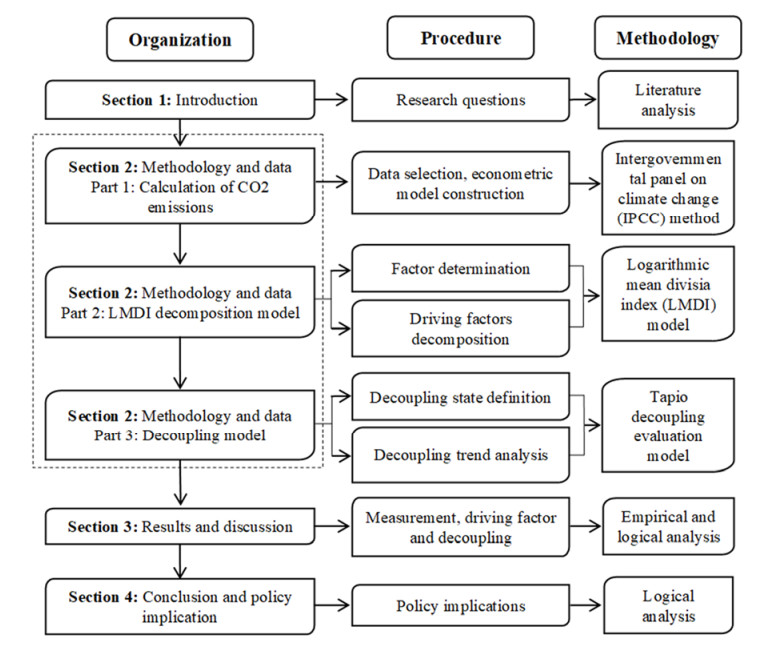









 DownLoad:
DownLoad:







